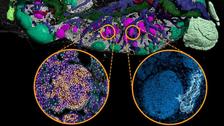3D reconstruction of the structural composition of the lymphatic vessels, blood vessels, and cell areas of a mandibular mouse lymph node. It shows the spatial and structural separation of the nodules (magenta) with the already known B-cell follicles (mint green). Correlative imaging methods reveal the ultrastructure of the densely packed B cells and their surroundings through loose tissue of the medulla and medullary sinuses. Like the B-cell follicles, the nodules are also surrounded by special high-endothelial venules, as shown by immunofluorescence staining specific for these venules (white). (Image: INI Research/ Paul Schütz)
Using a high-resolution X-ray technique at the Hereon beamline at PETRA III at DESY, an interdisciplinary team involving the Helmholtz-Zentrum Hereon has revealed novel structures in the lymphatic system of mammals. The 3D images reveal small, previously overlooked clusters of dormant B cells – known as nodules – which are thought to play an important role in the basic readiness of the immune system. The findings expand our understanding of how lymph nodes are structured and how they control immune cells. The study was recently published in the journal Frontiers in Immunology.
Our immune system is constantly on call: To ward off pathogens, it activates antibodies, white blood cells and phagocytes. But despite intensive research, many details about its structure and functioning remain unclear. Thanks to a newly state-of-the-art X-ray technique developed by a research team involving the Hereon Institute for Materials Physics and the Institute for Biomedical Imaging at the Technical University of Munich (TUM), the team has now been able to unravel a new detail at the PETRA III beamline P05 operated by Hereon at DESY: In mice, the experts discovered previously unknown reservoirs of dormant defence cells of the immune system, in a specific type of lymph node.
The discovery was made possible by a special CT technique called phase-contrast microtomography. "This method allows us to directly observe the three-dimensional structure of biological tissue down to the cellular level without having to use additional dyes or markers," explains Jörg Hammel, a biologist at the Hereon branch office in Hamburg.
Inexperienced immune cells
"We refer to these clusters of B cells that we have found as nodules," explains Florian Schwarzenberg, one of the two lead authors of the publication. "These cells appear to be immature and have not yet come into contact with pathogens." Unlike B-cell follicles – which are similar but significantly larger structures – nodules show no signs of active immune responses. However, like the follicles, they are closely connected to certain blood vessels through which immune cells can enter the tissue. Stephan Henne's team from the Interdisciplinary Neurobiological Immunology (INI-Research GmbH) working group was able to visualise this using X-rays, electron microscopy and special immunohistochemical analyses.
Reaction to permanent antigen stress
The nodules usually develop between the second and fourth week of life in mice. They are found exclusively in lymph nodes associated with mucous membranes. Their frequency appears to increase significantly with age. The data suggest that the newly discovered accumulations of B cells do not represent pathological changes, but rather specialised niches for B cells. Apparently, they ensure permanent immune readiness and help to keep the functioning and structure of the lymph nodes stable in the long term. In addition, experts suspect that they occur particularly in areas that are constantly exposed to foreign substances and pathogens – such as mucosal-associated lymph nodes.
New understanding of lymph node architecture
These findings show that certain deeper lymph nodes inside the body are structured differently from the superficial lymph nodes under the skin. Deep-seated nodes contain special areas that are thought to be important for how the immune system controls B cells and keeps them in balance. The researchers also observed that these lymph nodes form more and more of these B-cell areas with age, instead of developing typical fat deposits. This suggests that they play a crucial role in monitoring and regulating the immune system, especially in old age.
(Partly from Hereon press release)
Reference:
Schütz Paul , Schwarzenberg Florian L. , Weber Lennert J. , Hammel Jörg U. , Siebels Bente , Nissen Paula , Leising Nenya , Jarick Katja J. , Walkenfort Bernd , Irvine Sarah C. , Bartl Jasmin , Herzen Julia , Lohr Christian , Wülfing Clemens , Henne Stephan, „Follicle-like niches outside the cortex? 3D phase-contrast µCT revealed medullary B cell nodules in mucosa-draining lymph nodes”, Frontiers in Immunology Volume 16 (2025) DOI: 10.3389/fimmu.2025.1674997







